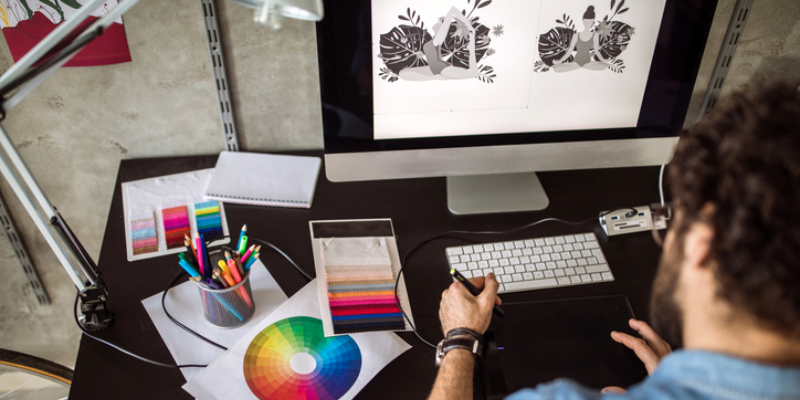
In graphic design, where creativity knows no bounds, one element often stands out for its simplicity and impact: white space. Also known as negative space, white space refers to the unmarked areas in a design. While it may seem like an empty canvas, white space plays a crucial role in enhancing a design’s overall aesthetic and functionality. In this blog, we will explore why white space is good for graphic design, its benefits, and how to use it effectively to create visually appealing and effective designs. Additionally, for those looking to enhance their skills in graphic design, Graphic Design Courses in Chennai offered by FITA Academy can provide comprehensive training and insights into mastering this essential aspect of design.
Understanding White Space
What is White Space?
White space is the portion of a page left unmarked: the margins, padding, line spacing, and gaps between design elements. It doesn’t necessarily have to be white; it can be any color or even a texture. The key idea is that it is an area free from text or images.
Types of White Space
White space can be categorized into two main types: active and passive. Active white space is intentionally left empty to create emphasis or visual interest, while passive white space results from the natural layout process, such as margins and padding. Both types are essential for creating a balanced design.
The Benefits of White Space in Graphic Design
Enhances Readability and Comprehension
One of the key advantages of white space is better reading. By providing breathing room around text and other elements, white space makes content easier to read and understand. It prevents visual clutter, allowing the viewer to focus on the message without feeling overwhelmed.
Creates a Balanced and Harmonious Layout
White space contributes to a well-balanced layout by providing visual separation between elements. This separation helps to organize information logically and ensures that the design doesn’t appear chaotic. A balanced layout guides the viewer’s eye through the content smoothly, making the overall experience more pleasant.
Emphasizes Important Elements
Using white space strategically can draw attention to specific elements within a design. White space makes it stand out more prominently by isolating a focal point, such as a headline or a call-to-action button. This technique is especially useful in advertising and web design, where quickly capturing the viewer’s attention is crucial.
Enhances Aesthetic Appeal
Designs that effectively use white space often appear more elegant and sophisticated. The minimalist approach, which relies heavily on white space, is known for its clean and modern look. This aesthetic appeal can enhance the perceived value of a brand or product, making it more attractive to the target audience.
Improves User Experience
In web design, white space plays a significant role in enhancing user experience. It helps create a clean and intuitive interface, making it easier for users to navigate and find information. By reducing cognitive load, white space ensures that users can interact with the design effortlessly, leading to higher satisfaction and engagement. Enrolling in a Graphic Design Online Course can provide valuable insights into utilizing white space effectively in web design to enhance user experience further.
How to Use White Space Effectively
Maintain Adequate Margins and Padding
Margins and padding are essential components of white space. Ensuring adequate spacing around elements prevents them from appearing cramped and allows each element to breathe. Consistent margins and padding throughout the design creates a cohesive and polished look.
Utilize Line Spacing and Paragraph Breaks
Proper line spacing and paragraph breaks are crucial for enhancing readability. Too little space between lines can make text difficult to read, while too much space can disrupt the flow. Finding the right balance ensures the text is easy on the eyes and guides the reader smoothly through the content.
Implement Grid Systems
Grid systems are invaluable tools for organizing content and maintaining consistent white space. They provide a structured framework that helps align elements accurately, ensuring a harmonious layout. A grid system allows designers to create well-proportioned designs with balanced white space.
Focus on Simplification
Embracing a minimalist approach by removing unnecessary elements can significantly enhance the use of white space. Simplification reduces visual clutter and directs attention to the most important aspects of the design. Every element should have a purpose, contributing to the overall message and aesthetics.
Experiment with Asymmetry
While symmetry is pleasing, asymmetrical designs can be equally effective when using white space. Asymmetry adds visual interest and dynamism to a design, making it more engaging. Designers can create a captivating and memorable composition by carefully balancing white space with asymmetrical elements.
White space is an essential yet often underestimated element in graphic design. It enhances readability, creates balance, emphasizes key elements, improves aesthetic appeal, and boosts user experience. By understanding the importance of white space and learning how to use it effectively, designers can create visually appealing and functional designs that stand out in a crowded marketplace. Embracing white space is not about leaving areas blank; it’s about making deliberate choices that contribute to the overall success of a design. So, the next time you embark on a design project, remember the power of white space and let it elevate your work to new heights. Enrolling in a Training Institute in Chennai can provide valuable insights into mastering these techniques and leveraging white space effectively in your designs. Also Read: Top 10 UI UX Training Institutes in Chennai